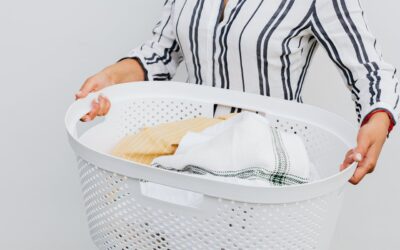Laundry is a necessary chore that we all have to do, but it can often be overwhelming and time-consuming. From sorting clothes to choosing the right detergent, there are many steps involved in doing laundry correctly. However, with a little knowledge and some helpful tips, you can make your laundry day more efficient and less stressful. In this article, we will discuss the importance of doing laundry properly and provide you with a comprehensive guide to help you tackle this task with ease.
Sorting Clothes: The First Step to a Successful Laundry Day
Sorting clothes before washing them is an essential step in the laundry process. It helps to prevent colors from bleeding onto each other and ensures that each garment receives the appropriate care. When sorting clothes, start by separating them into different piles based on color and fabric type. This will help you avoid any mishaps and keep your clothes looking their best.
When sorting by color, separate your clothes into three main categories: whites, lights, and darks. Whites should be washed separately to prevent them from becoming dingy or gray. Lights include pastel colors and light neutrals, while darks consist of deep colors like black, navy, and dark reds. Sorting by fabric type is also important because different fabrics require different care. Delicate fabrics like silk or lace should be washed separately or placed in a mesh laundry bag to protect them from damage.
Choosing the Right Detergent: A Guide to Laundry Products
Choosing the right detergent is crucial for achieving clean and fresh-smelling clothes. There are various types of laundry detergents available in the market, including liquid, powder, and pods. Liquid detergents are versatile and can be used for both regular and high-efficiency (HE) washing machines. Powder detergents are great for heavily soiled clothes and can be more cost-effective. Pods are convenient and pre-measured, making them easy to use, but they may not be suitable for all types of washing machines.
When selecting a detergent, consider your specific needs and preferences. If you have sensitive skin or allergies, opt for a hypoallergenic or fragrance-free detergent. For tough stains, look for a detergent with stain-fighting properties. It’s also important to follow the manufacturer’s instructions for dosage, as using too much detergent can leave residue on your clothes and washing machine.
Understanding Fabric Care Labels: How to Wash Clothes Correctly
Fabric care labels provide valuable information on how to properly care for your clothes. They include symbols and instructions that indicate the appropriate washing temperature, cycle, and drying method for each garment. It’s essential to read and understand these labels before washing your clothes to avoid damaging them.
The washing temperature symbol indicates the maximum temperature at which the garment can be washed. A symbol with a hand in the tub means the item should be hand-washed only. The cycle symbol indicates the appropriate wash cycle for the garment, such as normal, delicate, or permanent press. The drying symbol indicates whether the garment can be tumble dried or should be air-dried.
If you’re unsure about a fabric care label, it’s best to err on the side of caution. When in doubt, wash the garment in cold water on a gentle cycle and air-dry it. This will help prevent any damage or shrinkage.
Pre-Treating Stains: Tips for Removing Tough Stains
Pre-treating stains before washing can significantly improve your chances of removing them successfully. Whether it’s a coffee spill or a grass stain, treating the stain promptly can prevent it from setting into the fabric and becoming more difficult to remove.
There are several methods you can use to pre-treat stains. One common method is to apply a stain remover directly to the affected area and let it sit for a few minutes before washing. Another method is to create a paste using a mixture of water and laundry detergent and apply it to the stain. You can also try soaking the stained garment in a solution of water and vinegar or using a pre-wash stain remover spray.
It’s important to follow the instructions on the stain remover product and test it on a small, inconspicuous area of the fabric before applying it to the stain. This will help ensure that the product doesn’t cause any damage or discoloration.
Loading the Washing Machine: Maximizing Space and Efficiency

Loading the washing machine efficiently is essential for maximizing space and ensuring that your clothes get clean. Start by evenly distributing the clothes around the agitator or drum, making sure not to overload the machine. Overloading can prevent clothes from getting properly cleaned and may cause excessive wear and tear on the machine.
To maximize space, consider using laundry bags or mesh laundry organizers for smaller items like socks or delicates. This will help prevent them from getting lost or tangled during the wash cycle. It’s also a good idea to turn delicate items inside out to protect them from damage.
When loading the machine, be mindful of any zippers, buttons, or hooks that could snag on other garments. Fasten any loose buttons or hooks and zip up zippers to prevent them from catching on other clothes.
Setting the Right Temperature: Hot, Warm, or Cold?
Choosing the right temperature setting for your clothes is crucial for achieving optimal cleaning results while preserving their quality. Most washing machines offer three temperature settings: hot, warm, and cold. Each setting has its own benefits and considerations.
Hot water is best for heavily soiled items and for killing bacteria and germs. It can also help remove oil-based stains like grease or lipstick. However, hot water can cause colors to fade and shrink certain fabrics, so it’s important to check the fabric care label before using this setting.
Warm water is suitable for most everyday laundry and can help remove stains and dirt effectively. It’s a good compromise between hot and cold water and is generally safe for most fabrics. However, like hot water, warm water can cause colors to fade over time.
Cold water is best for delicate fabrics, dark colors, and items that are prone to shrinking or fading. It’s also more energy-efficient than using hot or warm water. While cold water may not be as effective at removing tough stains, it can still provide satisfactory results for most laundry.
Choosing the Right Cycle: Understanding the Different Wash Settings
Understanding the different wash settings available in your washing machine can help you choose the right cycle for your clothes. Most machines offer a variety of cycles, including normal, delicate, permanent press, and heavy-duty. Each cycle is designed to provide optimal cleaning results for specific types of garments.
The normal cycle is suitable for everyday laundry and can handle a variety of fabrics and soil levels. It typically uses a medium agitation speed and a regular spin speed.
The delicate cycle is designed for fragile fabrics like silk or lace that require gentle handling. It uses a slow agitation speed and a low spin speed to minimize the risk of damage.
The permanent press cycle is ideal for wrinkle-resistant fabrics like polyester or blends. It uses a slow agitation speed and a cool-down period at the end of the cycle to reduce wrinkling.
The heavy-duty cycle is best for heavily soiled items or large loads. It uses a high agitation speed and a longer wash time to ensure thorough cleaning.
When choosing a wash setting, consider the fabric type, soil level, and any specific care instructions provided on the fabric care label. It’s also important to avoid overloading the machine, as this can affect the effectiveness of the wash cycle.
Drying Clothes: Tips for Using the Laundromat Dryer
Using the laundromat dryer efficiently can help you save time and energy. Start by removing any lint from the lint trap before using the dryer. A clogged lint trap can reduce the dryer’s efficiency and increase drying time.
When loading the dryer, shake out each garment to remove any wrinkles and evenly distribute them around the drum. Overloading the dryer can prevent clothes from drying properly and may cause them to become wrinkled or damaged.
Choose the appropriate drying setting based on the fabric type and desired level of dryness. Most dryers offer settings like regular, permanent press, delicate, and air dry. The regular setting is suitable for most everyday laundry, while the delicate setting is best for fragile fabrics. The permanent press setting is ideal for wrinkle-resistant fabrics, and the air dry setting is suitable for items that should not be exposed to heat.
It’s important to check the dryer periodically during the drying cycle to prevent over-drying or shrinking. Remove clothes promptly once they are dry to prevent wrinkles from setting in.
Folding and Storing Clothes: How to Keep Your Clothes Looking Great
Folding and storing clothes properly can help keep them looking great even after washing them. Start by folding each garment neatly to avoid wrinkles and creases. There are various folding techniques you can use depending on the type of clothing item.
For t-shirts, fold them in half lengthwise and then fold them in thirds horizontally. This will create a compact and uniform fold. For pants or jeans, fold them in half lengthwise and then fold them in half again so that the legs are aligned. For sweaters or knitwear, fold them in half lengthwise and then fold them into thirds vertically.
When storing clothes, consider using storage bins or drawers to keep them organized and protected from dust or pests. It’s also a good idea to separate seasonal items and store them separately to save space.
Laundromat Etiquette: Tips for Sharing the Space with Others
When using a laundromat, it’s important to be considerate of others and follow the rules and regulations. Here are some tips for practicing good laundromat etiquette:
1. Be mindful of your time: Avoid leaving your clothes unattended for long periods, as this can inconvenience others who are waiting for a machine.
2. Clean up after yourself: Remove any lint from the dryer and wipe down the machines after use. This will help keep the laundromat clean and pleasant for everyone.
3. Respect others’ space: Avoid taking up more than one machine at a time if there are others waiting. If you need to use multiple machines, be mindful of others and finish your laundry as quickly as possible.
4. Follow the rules: Familiarize yourself with the laundromat’s rules and regulations, such as operating hours, machine usage limits, and any specific guidelines for using certain machines or products.
5. Be considerate of noise: Keep noise levels to a minimum by avoiding loud conversations or playing music without headphones. Remember that others may be trying to relax or work while waiting for their laundry.
Doing laundry doesn’t have to be a daunting task. By following these tips and guidelines, you can make your laundry day more efficient and less overwhelming. From sorting clothes to choosing the right detergent and understanding fabric care labels, each step plays a crucial role in achieving clean and fresh-smelling clothes. By practicing good laundry habits and being considerate of others when using a laundromat, you can make the experience more enjoyable for everyone involved. So, next time you tackle your laundry pile, remember these tips and have a successful laundry day!
If you’re looking for more tips on maintaining the perfect appearance of your clothes, you might find our article on “Perfect Pressing for Impeccable Business and Evening Outfits” helpful. This article provides valuable insights and techniques for achieving wrinkle-free garments that are suitable for any professional or formal occasion. Check it out to enhance your laundry skills and keep your wardrobe looking sharp.
FAQs
What is a Laundromat?
A Laundromat is a self-service laundry facility where customers can wash and dry their clothes using coin-operated machines.
How do I choose the right washing machine at a Laundromat?
Choose a washing machine based on the size of your laundry load. Most Laundromats have machines that can accommodate small, medium, and large loads.
How much does it cost to use a Laundromat?
The cost of using a Laundromat varies depending on the location and the type of machine you use. Typically, washing machines cost between $2 and $5 per load, while dryers cost between $0.25 and $0.50 per 10 minutes.
What should I bring to a Laundromat?
Bring your laundry detergent, fabric softener, and any other laundry supplies you may need. You may also want to bring a laundry basket or bag to transport your clothes.
How do I use a Laundromat washing machine?
First, sort your laundry by color and fabric type. Then, load the machine with the appropriate amount of laundry and detergent. Select the appropriate wash cycle and start the machine. Once the cycle is complete, transfer your clothes to a dryer or hang them to dry.
How do I use a Laundromat dryer?
Load the dryer with your wet clothes and select the appropriate drying cycle. Insert the required amount of coins and start the machine. Check your clothes periodically to ensure they are drying evenly.
What should I do if I have trouble using a Laundromat machine?
If you have trouble using a Laundromat machine, ask the attendant for assistance. They can help you operate the machine or troubleshoot any issues you may be experiencing.




